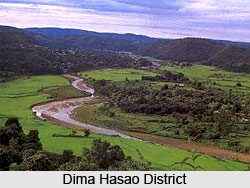History of Dima Hasao District narrates the course of formation and development of the district. Before 1832, Dima Hasao district was included in the Kachari Kingdom. Kachari kingdom spanned from the foot hills of the Lushai in the south up to the Jamuna in the North and from Katcha Naga and Angami Hills in the East up to the Kopili in the West. The kings of Karachi had made Dima Hasao, one of their capitals. In the year 1830 Dimasa king, Gobinda Chandra, was killed by his general Gambhir Singh. On 14th August 1832, the southern part of the kingdom was captured by the British government. The rest of the territory was then ruled by Tularam, the Dimasa General. Later in 1837, some more part of this kingdom was also captured by the British. After the death of Tularam in the year 1854, the remaining part of the Kingdom was also brought under the control of British Government and was made a part of Asalu sub-division.
 In 1867, the subdivision of Asalu was abolished and was divided and allocated to the districts Nagaon, Cachar, Jaintia Hills and Khasi. The region of Dima Hasao district was in the Cachar district. It was made a subdivision in the year 1880 with its headquarters located at Gunjung. Later in 1895 the headquarters was shifted to Haflong from Gunjung. On 17th November 1951, a new civil district was created by the name of `United district of North Cachar and Mikir Hills`. After this, two councils namely the NC Hills district council and Mikir Hills District Council were enacted as per the 6th schedule of constitution. Dima Hasao District Council was enacted in 1952, on 19th April.
In 1867, the subdivision of Asalu was abolished and was divided and allocated to the districts Nagaon, Cachar, Jaintia Hills and Khasi. The region of Dima Hasao district was in the Cachar district. It was made a subdivision in the year 1880 with its headquarters located at Gunjung. Later in 1895 the headquarters was shifted to Haflong from Gunjung. On 17th November 1951, a new civil district was created by the name of `United district of North Cachar and Mikir Hills`. After this, two councils namely the NC Hills district council and Mikir Hills District Council were enacted as per the 6th schedule of constitution. Dima Hasao District Council was enacted in 1952, on 19th April.
This article is a stub. You can enrich by adding more information to it. Send your Write Up to content@indianetzone.com



















